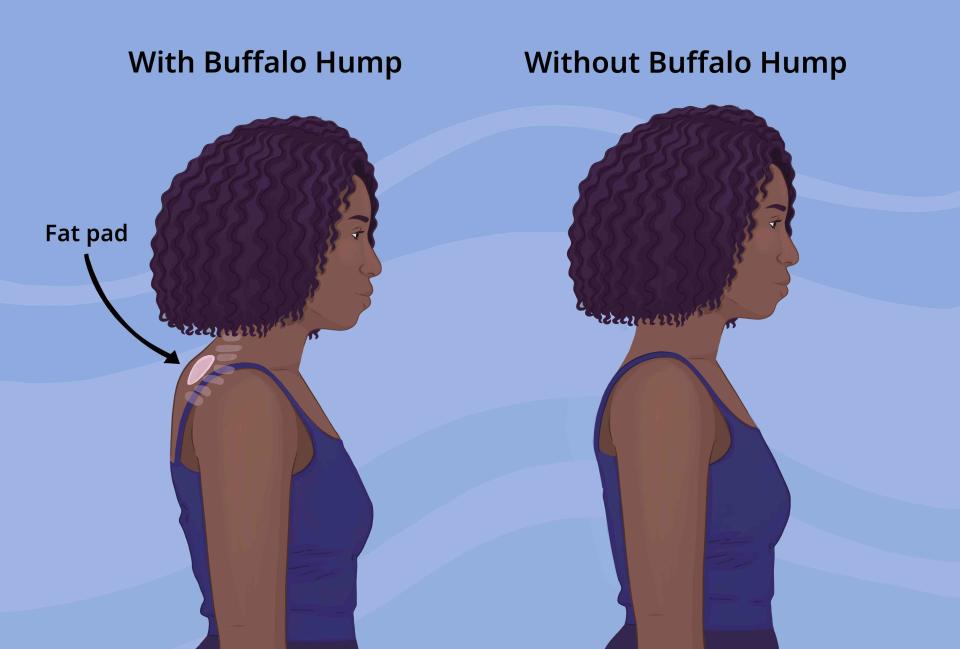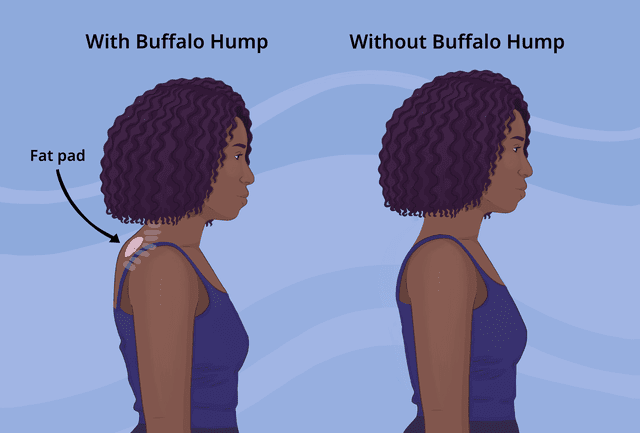Can You Get Rid of a Buffalo Hump?
Treatment Options for a Hump Behind the Neck

Illustration by Zoe Hansen for Verywell Health
Medically reviewed by Danielle Weiss, MD
A buffalo hump—also known as a dorsocervical fat pad—is an accumulation of fatty adipose tissue on the back of the neck in between your shoulder blades. This fat pad creates the look of a hump behind the shoulders.
This issue can be caused by a variety of conditions and medications and in some instances may be reversible.
This article will detail the potential origins of this condition and will outline how to get rid of a buffalo hump.

Illustration by Zoe Hansen for Verywell Health
Why Do People Have a Buffalo Hump?
Several different medical diagnoses and medications can lead to a dorsocervical fat pad. Among the most common buffalo hump causes are:
Cushing’s syndrome: A rare condition in which the body’s adrenal gland releases excess amounts of a hormone called cortisol. The overproduction of cortisol often triggers a fatty deposit of adipose tissue to develop on the back of the neck.
Cushing's disease: This is the most common form of Cushing's syndrome that occurs when a pituitary tumor signals for too much cortisol to be released.
Long-term use of glucocorticoid medications: Chronic use of glucocorticoids (like prednisone, dexamethasone, or hydrocortisone) is another common buffalo hump cause. This is because long-term use of these medications also triggers excessive amounts of cortisol released by the adrenal gland. Glucocorticoids are commonly prescribed to treat multiple sclerosis and other autoimmune diseases.
Antiretroviral (ART) medications: These are used to treat human immunodeficiency virus (HIV) and AIDS, and can trigger excessive fatty tissue to develop in the upper back.
Madelung disease (also known as multiple symmetrical lipomatosis): An uncommon metabolic disorder, also causes extra adipose tissue to accumulate in the neck, shoulders, and upper arms.
Obesity: This may cause a dorsocervical fat pad, though the fatty deposits from this condition are usually more diffuse, appearing across the body.
Buffalo Hump vs. Dowager's Hump
A buffalo hump, which is caused by a buildup of adipose tissue, is different from a Dowager’s hump. A Dowager’s hump is an excessive curvature (called kyphosis) in the upper back caused by poor posture or osteoporosis.
Common Treatment Methods for Buffalo Humps
The first step in treating a buffalo hump is to identify the root cause of the issue.
Your healthcare provider will commonly order laboratory tests to analyze cortisol levels in your body. They will also evaluate your current medication regimen to check for drugs that may lead to excessive fatty deposits.
Ineffective Treatments
Because a buffalo hump is caused by excess fatty tissue, interventions like chiropractic manipulation or stretching routines are generally ineffective treatments.
Once your healthcare provider's examination is complete, they will outline the steps needed to treat your buffalo hump.
In some cases, treatment may include:
Weight loss
Dietary modifications
Maintaining a regular exercise routine
These changes may help reduce fatty accumulations in the body and may trigger your buffalo hump to diminish in size.
It is important to note that many buffalo hump treatments can take time to work, and it is not possible to reduce the size of the hump in every situation.
Medication Adjustments to Treat Buffalo Hump
One of the primary treatments for a buffalo hump is adjusting (or eliminating) the medications that are causing the issue in the first place.
Your healthcare provider will work with you to modify the dosage or type of medication you are taking or to identify alternatives to your current regimen.
In the case of Cushing’s syndrome, they may also prescribe an additional medication to lower the system levels of cortisol in your body. It is important, however, to only stop or reduce your medications under the direction of your healthcare provider.
Learn More: Cushing's Syndrome Resulting From Corticosteroids
Buffalo Hump Complications
Depending on the size of the fatty deposit, a buffalo hump can lead to a number of complications. Larger fat deposits may restrict movement in the neck or upper back and impede functional tasks like driving, dressing, or sleeping. In rarer cases, a hump may also press down on a nerve in the region and cause pain or numbness.
Surgical Hump Removal
If initial treatments are not effective and your buffalo hump is causing significant pain or reduced function, surgical removal may be necessary. This rare intervention is usually performed by a plastic surgeon.
In addition, the conditions that cause a buffalo hump can lead to a variety of other symptoms.
Cushing’s disease may cause facial roundness, thinning or fragile skin, extreme fatigue, hypertension (high blood pressure), excess facial or body hair growth, irritability, and depression.
In the case of Madelung’s disease, peripheral neuropathy, difficulty speaking or swallowing, and sleep apnea may also be present.
Coping and Body Acceptance With a Buffalo Hump
It can be frustrating to deal with a newly developed buffalo hump, especially if it is large or significantly limits your ability to function.
Focusing on the things that are within your control can help you cope with this condition. This includes:
Speaking with a trusted medical professional is crucial to understanding the available treatments.
Staying active and maintaining a healthy diet can also help you look and feel better as you navigate this issue.
Joining an online support group for Cushing’s or Madelung’s disease can help you connect with others in a similar situation.
Summary
A buffalo hump deposits excess fat tissue on the back of the neck. This condition, also referred to as a dorsocervical fat pad, is most commonly caused by Cushing’s syndrome, including Cushing's disease, or chronic use of glucocorticoid medications. In rarer cases, antiretroviral medications, Madelung’s disease, or generalized obesity may also be to blame. Treatments include medication changes, diet and exercise, and in rare cases cosmetic surgery.

